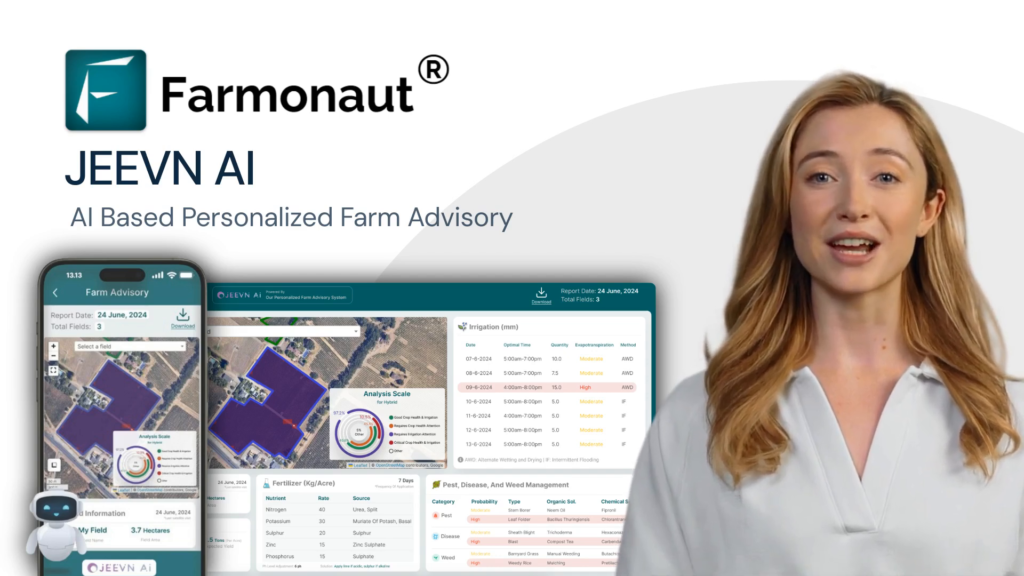Hurricane-Proof Your Farm: Essential Crop Insurance and Risk Management Strategies for Southern Farmers
“Recent hurricanes have significantly impacted agriculture in several states, prompting the development of essential federal crop insurance programs for farmers.”
As we navigate the ever-changing landscape of agriculture in the southern United States, one challenge looms larger than ever: the threat of hurricanes. These powerful storms can devastate crops, livestock, and livelihoods in a matter of hours. That’s why we at Farmonaut are committed to providing farmers with the tools and knowledge they need to protect their farms and secure their futures.
In this comprehensive guide, we’ll explore the critical components of agricultural risk management, with a focus on crop insurance and hurricane protection for farmers. We’ll delve into the impact of recent hurricanes on agriculture across multiple states, outline essential federal crop insurance programs, and discuss how cutting-edge technology can complement these efforts to create a more resilient farming future.

Understanding the Impact of Hurricanes on Southern Agriculture
The southern United States, particularly states like Florida, Georgia, North Carolina, South Carolina, and Virginia, have borne the brunt of numerous hurricanes in recent years. These natural disasters have left an indelible mark on the agricultural landscape, causing widespread crop damage, livestock losses, and long-term economic repercussions.
- Crop Destruction: High winds and flooding can flatten fields of corn, soybeans, cotton, and other staple crops.
- Livestock Losses: Flooding and infrastructure damage can lead to significant losses in poultry, cattle, and other livestock operations.
- Infrastructure Damage: Farm buildings, irrigation systems, and machinery can be severely damaged or destroyed.
- Soil Erosion: Heavy rainfall and storm surge can wash away valuable topsoil, impacting future growing seasons.
- Long-term Economic Effects: The ripple effects of hurricane damage can be felt for years, affecting local economies and food supply chains.
Given these devastating impacts, it’s crucial for farmers to have robust risk management strategies in place. This is where crop insurance and other protective measures come into play.
Federal Crop Insurance Programs: A Safety Net for Farmers
The United States Department of Agriculture (USDA) offers several crop insurance programs designed to protect farmers from losses due to natural disasters, including hurricanes. These programs are administered by the Risk Management Agency (RMA) and are an essential part of agricultural risk management.
Key Federal Crop Insurance Programs include:
- Multi-Peril Crop Insurance (MPCI): Covers loss of crop yields from all types of natural causes, including destructive weather.
- Whole-Farm Revenue Protection: Insures all commodities on a farm under one policy against natural disasters and market fluctuations.
- Livestock Insurance: Protects against losses in market value for cattle, swine, and other livestock.
- Hurricane Insurance Protection – Wind Index (HIP-WI): A specialized program providing rapid indemnity payments for crop losses due to hurricanes.
Let’s take a closer look at the Hurricane Insurance Protection – Wind Index (HIP-WI), as it’s particularly relevant for southern farmers facing hurricane risks.
Hurricane Insurance Protection – Wind Index (HIP-WI)
The HIP-WI is a relatively new addition to the federal crop insurance arsenal, designed specifically to address the unique challenges posed by hurricanes. Here are some key features of this program:
- Swift Indemnity Payments: HIP-WI provides rapid payments to affected producers, often within weeks of a hurricane event.
- Wind-Based Index: Payments are triggered based on maximum sustained winds in a producer’s county, as reported by the National Hurricane Center.
- Coverage Area: Available in hurricane-prone states, including Florida, Georgia, Hawaii, Louisiana, Mississippi, North Carolina, South Carolina, Texas, and Virginia.
- Complementary Coverage: HIP-WI can be added to underlying crop insurance policies for additional protection.
For southern farmers, the HIP-WI represents a crucial tool in their risk management arsenal. By providing swift financial assistance in the wake of a hurricane, it can help farmers recover more quickly and maintain their operations through challenging times.
“The Hurricane Insurance Protection – Wind Index (HIP-WI) provides rapid indemnity payments to farmers affected by hurricanes across multiple states.”
Emergency Procedures and Disaster Assistance
In addition to insurance programs, farmers should be aware of emergency procedures and disaster assistance available in the aftermath of a hurricane. The USDA and other federal agencies offer various forms of support to help farmers recover and rebuild.
Key disaster assistance programs include:
- Emergency Conservation Program (ECP): Provides funding to rehabilitate farmland damaged by natural disasters.
- Emergency Forest Restoration Program (EFRP): Assists owners of non-industrial private forests in restoring forest health.
- Emergency Assistance for Livestock, Honeybees, and Farm-Raised Fish Program (ELAP): Provides emergency relief for losses due to disease, adverse weather, or other conditions.
- Noninsured Crop Disaster Assistance Program (NAP): Offers financial assistance to producers of non-insurable crops when low yields, loss of inventory, or prevented planting occur due to natural disasters.
Farmers should familiarize themselves with these programs and the application processes before disaster strikes. Being prepared can make a significant difference in the speed and effectiveness of recovery efforts.
Leveraging Technology for Enhanced Risk Management
While federal programs provide a crucial safety net, modern farmers are increasingly turning to technology to complement these efforts and enhance their risk management strategies. This is where Farmonaut’s advanced agricultural technology solutions come into play.
Farmonaut offers a suite of tools that can help farmers:
- Monitor crop health in real-time using satellite imagery
- Receive AI-powered advisory services for optimal crop management
- Track and manage resources more efficiently
- Assess and mitigate risks related to weather and climate patterns
By integrating these technological solutions with traditional insurance and disaster assistance programs, farmers can create a more comprehensive and proactive approach to risk management.
Comparing Hurricane Risk Management Strategies
To help farmers make informed decisions about their risk management approach, we’ve compiled a comparison table of various strategies available:
| Strategy Name | Type | Coverage Area | Key Benefits | Estimated Cost Range | Response Time for Assistance | Compatibility with Other Programs |
|---|---|---|---|---|---|---|
| Hurricane Insurance Protection – Wind Index (HIP-WI) | Insurance | Hurricane-prone states | Rapid indemnity payments | Variable, based on coverage level | Weeks | Can be added to underlying policies |
| Traditional Federal Crop Insurance | Insurance | Nationwide | Comprehensive coverage for various perils | Varies by crop and coverage level | Months | Compatible with most federal programs |
| Farmonaut’s Real-Time Crop Monitoring | Technology | Global | Proactive risk assessment and management | Subscription-based | Real-time | Complements insurance and assistance programs |
| Disaster Assistance Programs | Government Aid | Nationwide | Financial assistance for recovery | Free to apply | Varies by program | Can be used alongside insurance |
| Emergency Farm Loans | Financial | Nationwide | Low-interest loans for recovery | Interest rates set by USDA | Weeks to months | Can supplement insurance payouts |
This comparison highlights the diverse range of options available to farmers for managing hurricane risks. By combining multiple strategies, farmers can create a robust risk management plan tailored to their specific needs and circumstances.
Best Practices for Hurricane Preparedness
While insurance and technology play crucial roles in risk management, proactive preparedness is equally important. Here are some best practices for farmers to consider:
- Develop an Emergency Plan: Create a comprehensive plan that outlines steps to take before, during, and after a hurricane.
- Secure Farm Infrastructure: Reinforce buildings, secure loose equipment, and ensure proper drainage systems are in place.
- Protect Livestock: Have a plan for evacuating or sheltering animals, and ensure adequate food and water supplies.
- Maintain Detailed Records: Keep up-to-date records of farm assets, production history, and financial information to expedite insurance claims and disaster assistance applications.
- Stay Informed: Monitor weather forecasts and official communications regularly during hurricane season.
- Invest in Resilient Crop Varieties: Consider planting crop varieties that are more resistant to wind and flood damage.
By implementing these practices and staying prepared, farmers can minimize potential losses and recover more quickly in the event of a hurricane.

The Role of Technology in Modern Farm Risk Management
As we’ve mentioned, technology plays an increasingly important role in farm risk management. Farmonaut’s suite of tools exemplifies how modern tech can enhance traditional risk management strategies:
- Satellite-Based Crop Health Monitoring: By leveraging multispectral satellite imagery, farmers can track crop health in real-time, identifying potential issues before they become major problems.
- AI-Powered Advisory Systems: Advanced algorithms can analyze farm data to provide personalized recommendations for crop management, helping farmers make informed decisions that mitigate risks.
- Weather Forecasting and Analysis: Accurate, localized weather predictions can help farmers prepare for potential weather-related risks, including hurricanes.
- Resource Management Tools: Efficient management of water, fertilizer, and other resources can improve overall farm resilience and sustainability.
By integrating these technological solutions with traditional insurance and disaster assistance programs, farmers can create a more comprehensive and proactive approach to risk management.
For more information on how Farmonaut’s technology can enhance your farm’s risk management strategy, visit our API Developer Docs or explore our API capabilities.
The Future of Agricultural Risk Management
As climate change continues to influence weather patterns and increase the frequency and intensity of hurricanes, the need for robust risk management strategies in agriculture will only grow. We anticipate several trends shaping the future of farm risk management:
- Increased Integration of Technology: Advanced monitoring and predictive tools will become standard in farm operations.
- More Specialized Insurance Products: Insurance providers may develop more tailored products to address specific risks faced by farmers in different regions.
- Greater Emphasis on Sustainability: Risk management strategies will increasingly incorporate sustainable farming practices to build long-term resilience.
- Enhanced Public-Private Partnerships: Collaboration between government agencies, insurance providers, and technology companies will lead to more comprehensive risk management solutions.
By staying informed about these trends and adopting a proactive approach to risk management, southern farmers can position themselves for success in an increasingly challenging agricultural landscape.
Conclusion: Building a Resilient Future for Southern Agriculture
Hurricane-proofing your farm is not just about surviving the next storm—it’s about building a resilient operation that can thrive in the face of various challenges. By combining federal crop insurance programs, disaster assistance, cutting-edge technology, and best practices in farm management, southern farmers can create a robust risk management strategy that protects their livelihoods and ensures the long-term sustainability of their operations.
Remember, effective risk management is an ongoing process. Regularly review and update your strategies, stay informed about new programs and technologies, and don’t hesitate to seek expert advice when needed. With the right approach, southern farmers can continue to produce the food and fiber that sustains our nation, even in the face of hurricane threats.
At Farmonaut, we’re committed to supporting farmers in this journey towards greater resilience and sustainability. Our advanced agricultural technology solutions are designed to complement traditional risk management strategies, providing farmers with the tools they need to make informed decisions and protect their operations.
Frequently Asked Questions
Q: What is the Hurricane Insurance Protection – Wind Index (HIP-WI)?
A: HIP-WI is a specialized crop insurance program that provides rapid indemnity payments to farmers affected by hurricanes. It’s based on a wind index and is available in hurricane-prone states.
Q: How can technology help in farm risk management?
A: Technology like Farmonaut’s solutions can provide real-time crop health monitoring, AI-powered advisory services, and efficient resource management tools. These technologies help farmers make informed decisions and mitigate risks proactively.
Q: Are there government assistance programs for farmers affected by hurricanes?
A: Yes, the USDA offers several disaster assistance programs, including the Emergency Conservation Program (ECP), Emergency Forest Restoration Program (EFRP), and others. These programs provide financial assistance for recovery and rehabilitation of farmland.
Q: How often should I review my farm’s risk management strategy?
A: It’s recommended to review your risk management strategy at least annually, or more frequently if there are significant changes in your operation or in climate patterns affecting your region.
Q: Can I combine multiple risk management strategies?
A: Absolutely. In fact, it’s often beneficial to use a combination of strategies, such as federal crop insurance, technological solutions like Farmonaut, and best practices in farm management, to create a comprehensive risk management plan.
















